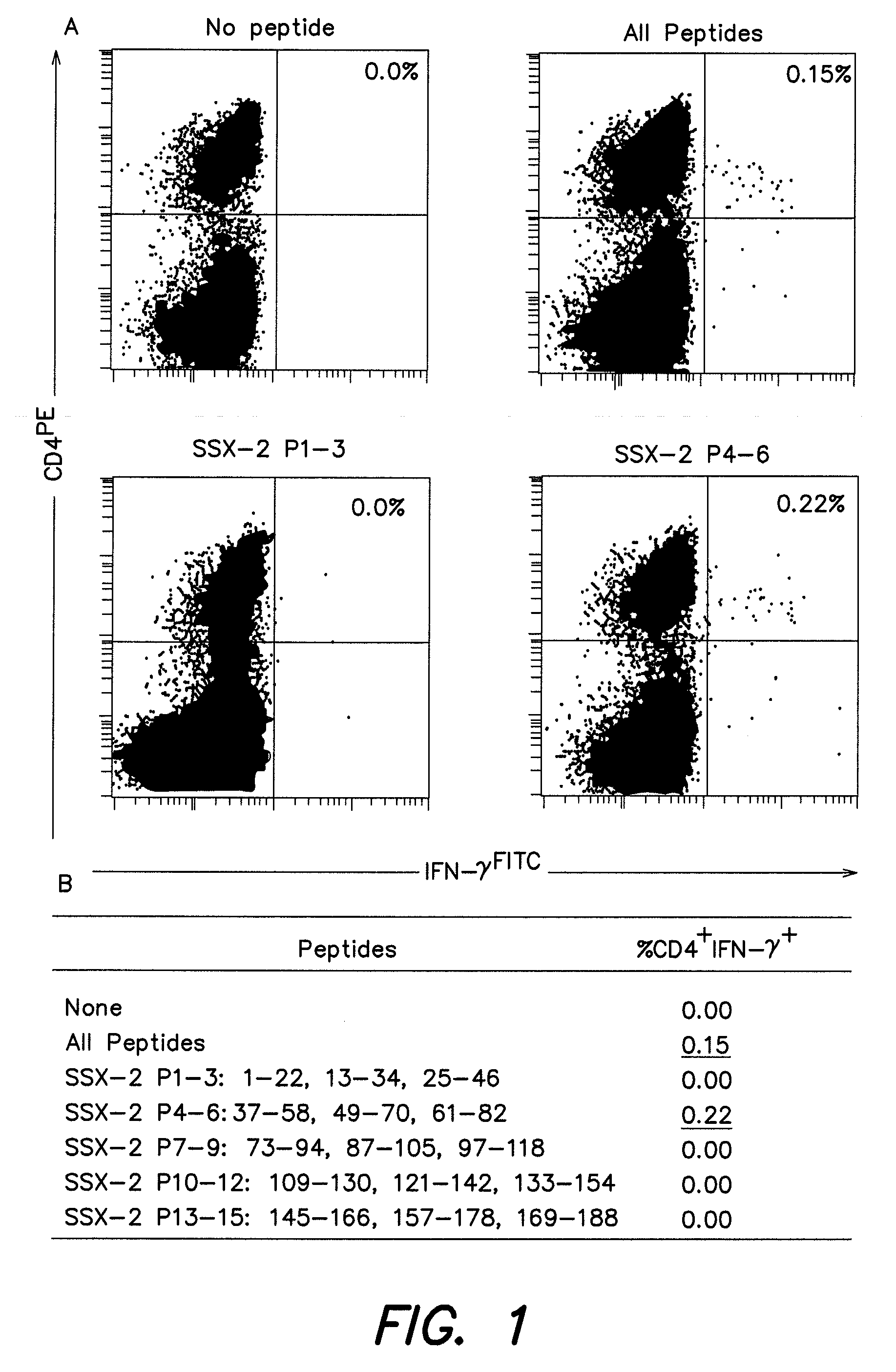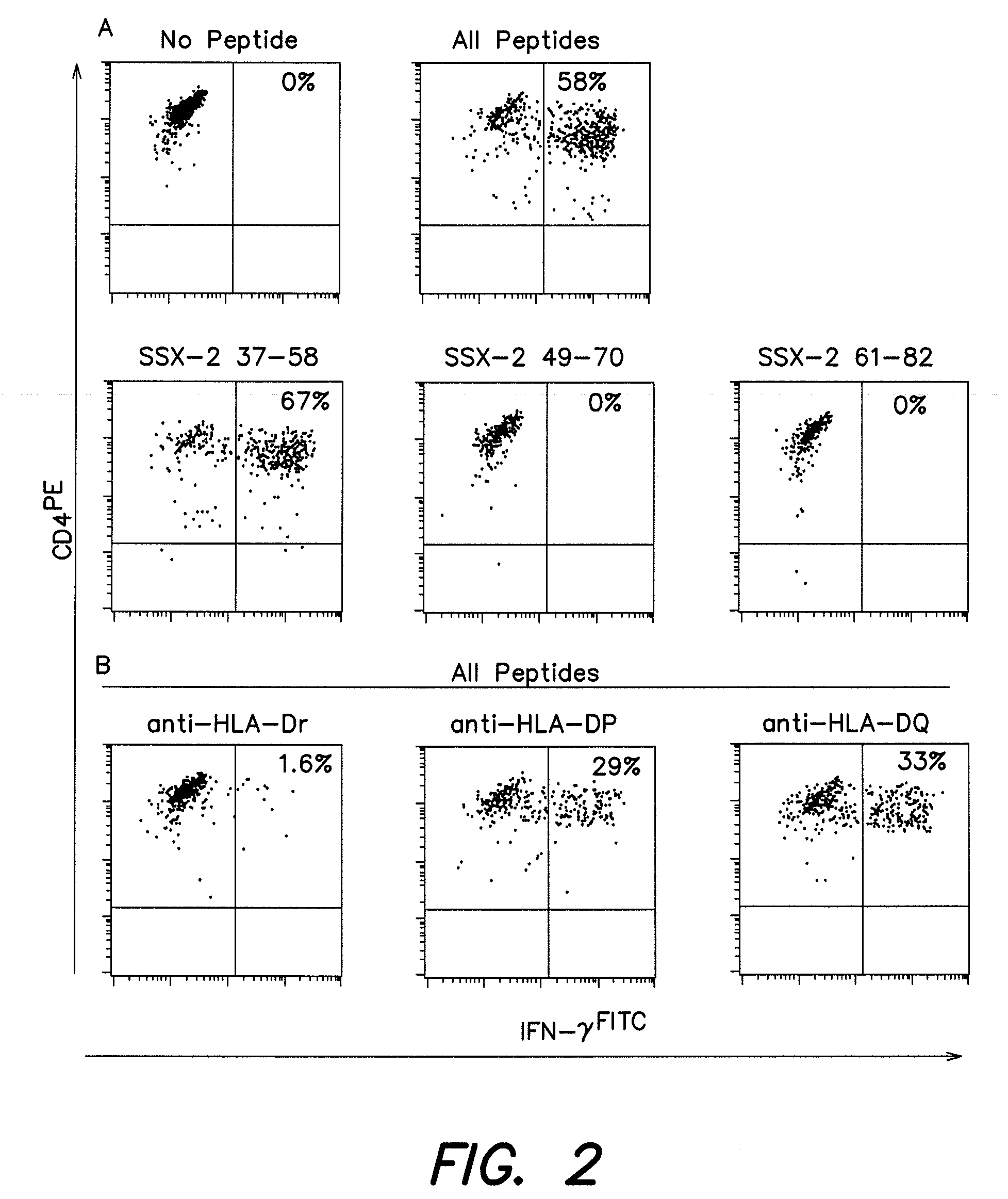Ssx-2 peptides presented by HLA class ii molecules
a technology of hla class and peptides, applied in the field of ssx2 peptides presented by hla class ii molecules, can solve the problems of complex process by which the mammalian immune system recognizes and reacts to foreign or alien materials, difficult identification of mhc class ii restricted epitopes recognized by tumor antigen specific cd4+ t cells, and many patients who would not benefit from any therapy. achieve the effect o
- Summary
- Abstract
- Description
- Claims
- Application Information
AI Technical Summary
Benefits of technology
Problems solved by technology
Method used
Image
Examples
example 1
Isolation of SSX-2 Specific CD4+ T Cells from Circulating Lymphocytes of an Antigen Expressing Melanoma Patient
[0151]As recombinant SSX-2 protein became available, we initiated a study to identify CD4+ T cell epitopes. To that purpose, we prepared monocyte-derived dendritic cells (DC) from patient LAU672 by isolating CD 14+ monocytes from PBMC by magnetic cell sorting. The obtained population (containing >95% CD14+ cells) was cultured in CTL medium containing 1,000 U / ml of rhGM-CSF and 1,000 U / ml of rhIL-4 during 6 days. At the end of the culture period, DC were incubated with recombinant SSX-2 protein for 12 hours and used to stimulate autologous CD4+ T cells isolated from PBMC by magnetic cell sorting.
[0152]Two weeks after stimulation, culture aliquots were tested using either a pool containing all SSX-2 overlapping peptides or submixtures, each composed of 3 peptides (P1-3, P4-6 etc., FIG. 1). The submixtures were composed as follows: P1-3 was composed of the peptides as set fort...
example 2
SSX-2 37-58 is Recognized by Specific CD4+ T cells from LAU672 in the Context of HLA-DR11
[0155]To identify the restriction element used by SSX-2 37-58 specific CD4+ T cells from patient LAU672, peptide presentation experiments were performed in the presence of antibodies that specifically block the recognition of antigens restricted by different MHC Class II elements (HLA-DR, -DP or -DQ). As illustrated in FIG. 2B, anti-HLA-DR antibodies almost completely inhibited peptide recognition by T cells. In contrast, only partial inhibition was observed using anti-HLA-DP or anti-HLA-DQ antibodies (FIG. 2B). The latter was to be considered non-specific as it was similarly observed when using an MHC-Class-I restricted CD8+ T cell clone.
[0156]To establish the presenting allele(s) we first analyzed the HLA-DR alleles of the patient. LAU 672 expressed HLA-DR11 and DR17. We then assessed presentation by partially matched APC from other melanoma patients. In the case of two patients expressing DR1...
example 3
Identification of the Minimal Peptide Sequence Optimally Recognized by SSX-2 Specific DR11-Restricted CD4+ T cells
[0158]To more precisely define the SSX-2-derived peptide optimally recognized by DR11-restricted specific CD4+ T cells from patient LAU 672, we analyzed the relative capacity of truncated variants of SSX-2 37-58 to stimulate IFN-γ secretion by specific T cells. As illustrated in FIG. 3, truncation of the peptide C-terminus resulted in decreased peptide recognition. In contrast, truncation of the first 8 amino acids at the N-terminus did not significantly affect recognition (peptides having SSX-2 amino acids 39-58 (SEQ ID NO:22), 41-58 (SEQ ID NO:23), 43-58 (SEQ ID NO:24), and 45-58 (SEQ ID NO:25)) relative to the parental peptide (SSX-2 37-58 (SEQ ID NO:10)). It is expected that the peptides having amino acid sequences differing from the foregoing peptides by one amino acid also would retain activity (i.e., peptides having SSX-2 amino acids 38-58, 40-58, 42-58, and 44-58...
PUM
| Property | Measurement | Unit |
|---|---|---|
| temperatures | aaaaa | aaaaa |
| temperatures | aaaaa | aaaaa |
| temperatures | aaaaa | aaaaa |
Abstract
Description
Claims
Application Information
 Login to View More
Login to View More - R&D
- Intellectual Property
- Life Sciences
- Materials
- Tech Scout
- Unparalleled Data Quality
- Higher Quality Content
- 60% Fewer Hallucinations
Browse by: Latest US Patents, China's latest patents, Technical Efficacy Thesaurus, Application Domain, Technology Topic, Popular Technical Reports.
© 2025 PatSnap. All rights reserved.Legal|Privacy policy|Modern Slavery Act Transparency Statement|Sitemap|About US| Contact US: help@patsnap.com



